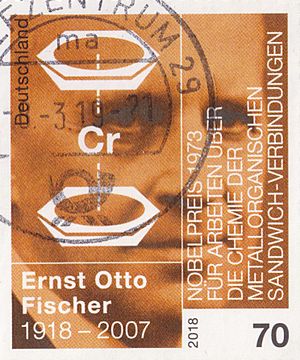Ernst Otto Fischer facts for kids
Quick facts for kids
Ernst Otto Fischer
|
|
|---|---|

Commemorative stamp, Germany 2018
|
|
| Born | 10 November 1918 Solln, near Munich, German Empire
|
| Died | 23 July 2007 (aged 88) Munich, Germany
|
| Nationality | Germany |
| Alma mater | Technical University of Munich |
| Known for | Organometallic compounds Ferrocene |
| Awards | Nobel Prize for Chemistry (1973) |
| Scientific career | |
| Fields | Chemistry |
| Institutions | Technical University of Munich |
| Doctoral advisor | Walter Hieber |
| Signature | |
 |
|
Ernst Otto Fischer (born November 10, 1918 – died July 23, 2007) was a German scientist. He was a chemist who won the Nobel Prize for his amazing work. He helped create a new field of chemistry called organometallic chemistry.
Contents
Growing Up and His Education
Ernst Otto Fischer was born in Solln, a town near Munich. His father, Karl T. Fischer, was a Physics Professor at the Technical University of Munich (TU). His mother was Valentine Danzer.
Ernst finished high school in 1937. After school, he had to join the military for two years. But then World War II started. He served in Poland, France, and Russia during the war.
In late 1941, while still in the military, he started studying chemistry at the Technical University of Munich. After the war ended in 1945, he was released and went back to his studies. He finished his chemistry degree in 1949.
His Chemistry Career
After graduating, Fischer worked on his PhD project. He was an assistant to Professor Walter Hieber in the Inorganic Chemistry department. His PhD work was about how certain chemicals react with nickel.
Discovering Ferrocene's Structure
After getting his PhD in 1952, he kept doing research. He studied special chemical compounds called organometallic compounds. These compounds have a bond between a metal and a carbon atom.
He focused on a compound called ferrocene. Other scientists had suggested a structure for ferrocene, but Fischer thought it might be wrong. He then showed that ferrocene has a unique "sandwich" structure. In this structure, an iron atom is "sandwiched" between two rings of carbon atoms. This discovery was very important in chemistry.
Becoming a Professor
Fischer became a lecturer at the Technical University of Munich in 1955. He quickly moved up, becoming a professor in 1957 and a full professor in 1959. In 1964, he became the head of the Inorganic Chemistry department at the university.
Awards and Recognition
Many important groups recognized Fischer's work. In 1964, he joined the Bavarian Academy of Sciences. In 1969, he became a member of the German Academy of Natural Scientists Leopoldina. The University of Munich gave him an honorary doctorate in 1972.
He traveled all over the world to give talks about his work. His research group also discovered new types of metal compounds. These are now known as Fischer carbenes and Fischer-carbynes.
Fischer wrote about 450 science articles. He also taught and guided many students who went on to have successful careers in chemistry. He was a visiting professor at several universities in the United States, including the University of Wisconsin–Madison and the Massachusetts Institute of Technology.
Nobel Prize Winner
In 1973, Ernst Otto Fischer won the Nobel Prize in Chemistry. He shared the prize with Geoffrey Wilkinson. They won for their important work on organometallic compounds. Their discoveries helped chemists understand how metals and carbon can bond together. This led to new ways of making medicines and other useful materials.
Later Life and Passing
Ernst Otto Fischer passed away on July 23, 2007, in Munich. At the time of his death, he was the oldest living German Nobel Prize winner.
See also
 In Spanish: Ernst Otto Fischer para niños
In Spanish: Ernst Otto Fischer para niños


